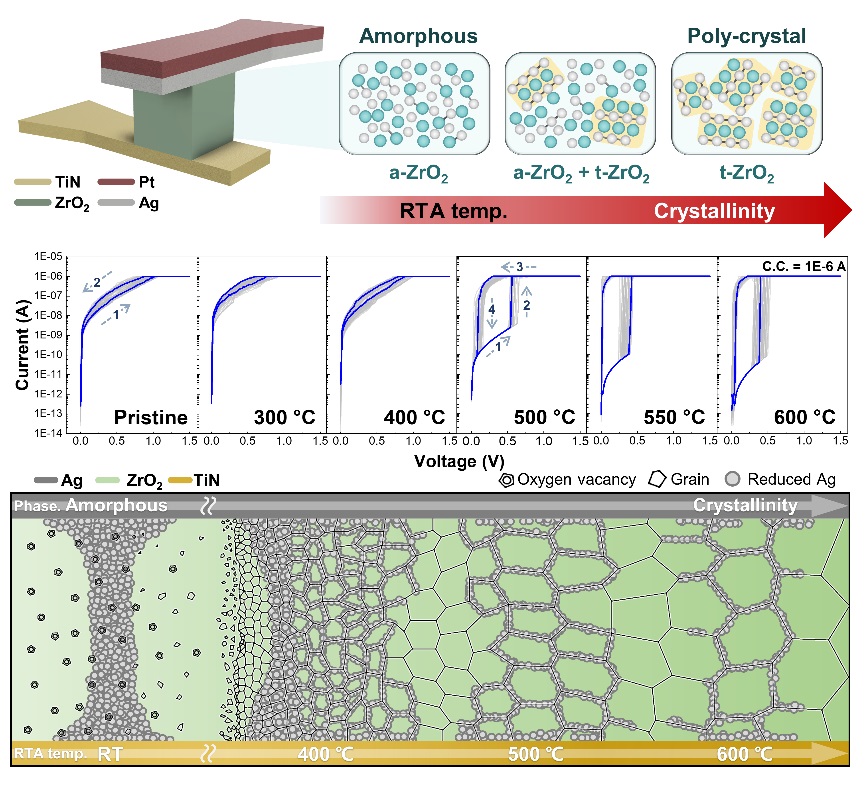이화여자대학교 융합전자반도체공학부 곽준영 교수팀과 한국과학기술원 신소재공학부 강기범 교수팀은 함께 저전력 뉴로모픽 컴퓨팅을 위한 산화지르코늄(ZrO2) 멤리스터 기반 스위치 소자를 개발하며, 향후 인공지능(AI) 하드웨어의 다양한 분야에서 폭넓은 활용이 기대된다. #한국연구재단 차세대 지능형반도체기술개발사업 #KIST 기관고유사업
높은 재현성·빠른 스위칭 속도·저전력 구동, 우수한 스위칭 성능 입증
국내 연구진에 의해 뉴로모픽 응용 분야에서 중요한 가능성을 제시할 수 있는 반도체 소자가 개발돼 향후 인공지능(AI) 하드웨어의 다양한 분야에서 폭넓은 활용이 기대된다.
이화여자대학교 융합전자반도체공학부 곽준영 교수팀과 한국과학기술원 신소재공학부 강기범 교수팀은 함께 저전력 뉴로모픽 컴퓨팅을 위한 산화지르코늄(ZrO2) 멤리스터 기반 스위치 소자를 개발했다고 최근 밝혔다.
이 연구는 차세대 인공지능 뉴로모픽 컴퓨팅, 확률론적 컴퓨팅, 레저버 컴퓨팅 등 다양한 응용 분야에서 중요한 역할을 할 것으로 기대된다.
멤리스터 기반의 스위치 소자는 전원이 인가되면 낮은 저항 상태로 전환되고, 전원이 꺼지면 높은 저항 상태로 복귀하는 특성을 갖고 있어 컴퓨팅 하드웨어 구현에 필수적으로 사용된다.
반면에 기존의 휘발성 멤리스터 소자는 이온 이동의 제어가 어렵고, 반복 동작 시 신뢰성이 낮아 실제 응용에 한계가 있었다.
이를 해결하기 위해, 연구팀은 산화지르코늄의 결정 구조를 이용해 전도성 필라멘트 형성을 정밀하게 제어하는 기술을 새롭게 제시했다.
급속 열처리 공정을 도입해 단일 산화물 층에서 필라멘트 경로를 형성함으로써 복잡한 다층 구조를 대체했고, 은(Ag) 이온의 이동 경로를 안정적으로 제공해 소자의 내구성을 크게 향상시켰다.
결정화된 ZrO2 기반의 멤리스터는 높은 재현성, 빠른 스위칭 속도, 저전력 구동을 통해 우수한 스위칭 성능을 입증했다.
이 기술은 복잡한 패턴 인식 작업에서도 효율적인 분석이 가능하며, 특히 레저버 컴퓨팅과 같은 뉴로모픽 응용 분야에서 중요한 가능성을 제시했다.
이번 연구는 차세대 인공지능 하드웨어의 다양한 분야에서 폭넓은 활용이 기대되며, 음성 및 이미지 인식에서 탁월한 성능을 확인했다.
음성 인식 시뮬레이션에서는 97.4%의 높은 정확도를 달성하여 앞으로 다양한 금속 산화물로 확장될 수 있을 것으로 보인다.
이번 연구 결과는 국제 저명 학술지 ‘InfoMat’에 ‘Crystallinity-controlled volatility tuning of ZrO2 memristor for physical reservoir computing’이라는 제목으로 커버 논문으로 선정되어 게재됐다.
한편 이번 연구결과는 한국연구재단 차세대 지능형반도체기술개발사업 및 KIST 기관고유사업 지원을 받아 수행됐다.

▲급속 열처리 공정을 통해 소자의 필라멘트 경로를 형성하는 효율적인 공정을 도입하여 이온의 이동 경로를 제공하여 안정적인 소자 동작을 구현함
